Having a bachelor’s diploma stays an essential benefit in lots of sectors of the U.S. labor market. School graduates typically out-earn those that haven’t attended faculty, and they’re extra prone to be employed within the first place. On the identical time, many People say they can’t afford to get a four-year diploma – or that they simply don’t wish to.
Listed here are key information about American faculty graduates.
This Pew Analysis Middle evaluation about U.S. faculty graduates depends on knowledge from sources together with the Census Bureau, the Bureau of Labor Statistics, the Nationwide Middle for Schooling Statistics, the Nationwide Scholar Clearinghouse and the Federal Reserve Financial institution, in addition to surveys carried out by the Middle.
Everybody who took the Pew Analysis Middle surveys cited is a member of the Middle’s American Developments Panel (ATP), an internet survey panel that’s recruited by way of nationwide, random sampling of residential addresses. This manner practically all U.S. adults have an opportunity of choice. The survey is weighted to be consultant of the U.S. grownup inhabitants by gender, race, ethnicity, partisan affiliation, training and different classes. Learn extra about the ATP’s methodology.
Practically four-in-ten People ages 25 and older have a bachelor’s diploma, a share that has grown during the last decade. As of 2021, 37.9% of adults on this age group held a bachelor’s diploma, together with 14.3% who additionally obtained a graduate or skilled diploma, in keeping with knowledge from the Census Bureau’s Present Inhabitants Survey. That share is up 7.5 share factors from 30.4% in 2011.
A further 10.5% had an affiliate diploma in 2021. About four-in-ten People ages 25 and older had a highschool diploma with no additional training (25.3%) or accomplished some faculty however didn’t have a level (14.9%).
In a reversal, girls are actually extra probably than males to graduate from faculty, in keeping with the Present Inhabitants Survey. In 2021, 39% of ladies ages 25 and older had a bachelor’s diploma or extra training, in contrast with 37% of males in the identical age vary. The hole in faculty completion is even wider amongst adults ages 25 to 34: 46% of ladies on this age group have not less than a bachelor’s diploma, in contrast with 36% of males.
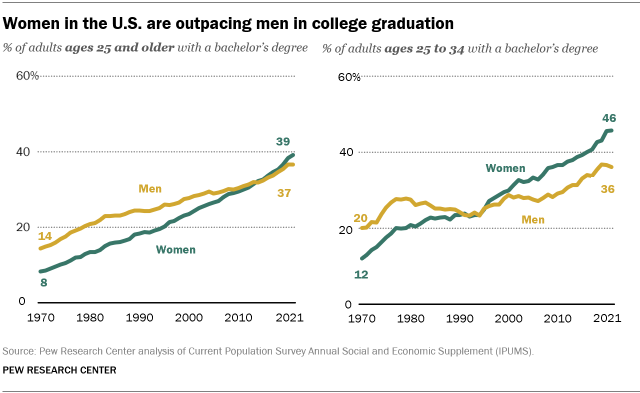
In an October 2021 Pew Analysis Middle survey of People with out a level, 34% of males mentioned a serious purpose why they haven’t obtained a four-year faculty diploma is that they simply didn’t wish to. Just one-in-four girls mentioned the identical. Males have been additionally extra prone to say a serious purpose they didn’t have a four-year diploma is that they didn’t want extra training for the job or profession they needed (26% of males mentioned this vs. 20% of ladies).
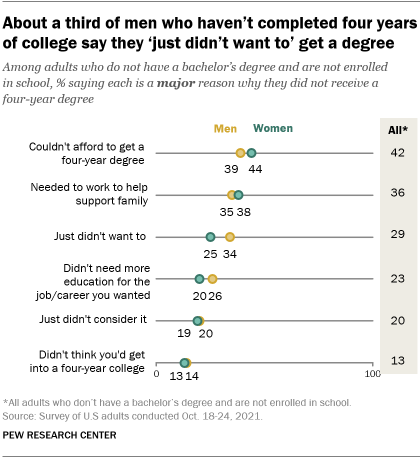
Girls (44%) have been extra probably than males (39%) to say not having the ability to afford faculty was a serious purpose they don’t have a bachelor’s diploma. Women and men have been about equally prone to say a serious obstacle was needing to work to assist help their household.
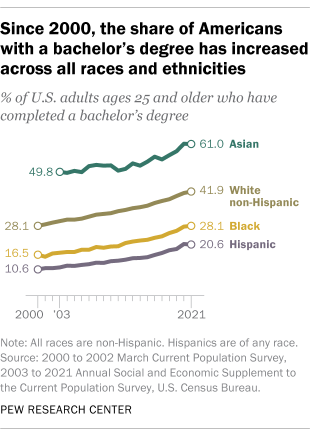
There are racial and ethnic variations in faculty commencement patterns, in addition to within the causes for not finishing a level. Amongst adults ages 25 and older, 61% of Asian People have a bachelor’s diploma or extra training, together with 42% of White adults, 28% of Black adults and 21% of Hispanic adults, in keeping with 2021 Present Inhabitants Survey knowledge. The share of bachelor’s diploma holders in every group has elevated since 2010. That yr, 52% of Asian People had a four-year diploma or extra, in contrast with a 3rd of White adults, 20% of Black adults and 14% of Hispanic adults.
The October 2021 Middle survey discovered that amongst adults with out a bachelor’s diploma, Hispanic adults (52%) have been extra probably than those that are White (39%) or Black (41%) to say a serious purpose they didn’t graduate from a four-year faculty is that they couldn’t afford it. Hispanic and Black adults have been extra probably than their White counterparts to say needing to work to help their household was a serious purpose.
Whereas a 3rd of White adults mentioned not desirous to go to high school was a serious purpose they didn’t full a four-year diploma, smaller shares of Black (22%) and Hispanic (23%) adults mentioned the identical. White adults have been additionally extra prone to cite not needing extra training for the job or profession they needed. (There weren’t sufficient Asian adults with out a bachelor’s diploma within the pattern to investigate individually.)
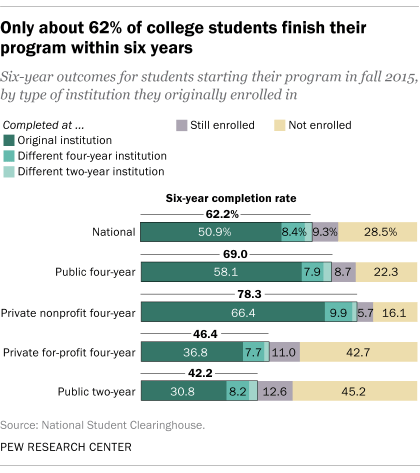
Solely 62% of scholars who begin a level or certificates program end their program inside six years, in keeping with the newest knowledge from the Nationwide Scholar Clearinghouse, a nonprofit verification and analysis group that tracked first-time faculty college students who enrolled in fall 2015 with the intent of pursuing a level or certificates. The diploma completion price for this group was highest amongst college students who began at four-year, personal, nonprofit colleges (78.3%), and lowest amongst those that began at two-year public establishments (42.2%).
Enterprise is probably the most generally held bachelor’s diploma, adopted by well being professions. In accordance with the Nationwide Middle for Schooling Statistics, about a fifth (19%) of the roughly 2 million bachelor’s levels conferred in 2019-20 have been in enterprise. Well being professions and associated applications have been the second most-popular subject, making up 12.6% of levels conferred that yr. Enterprise has been the one commonest main since 1980-81; earlier than that, training led the way in which.
The least frequent bachelor’s levels in 2019-20 have been in army applied sciences and utilized sciences (1,156 levels conferred in 2019-20), library science (118), and precision manufacturing (39).
There’s a rising earnings hole between younger faculty graduates and their counterparts with out levels. In 2021, full-time staff ages 22 to 27 who held a bachelor’s diploma, however no additional training, made a median annual wage of $52,000, in contrast with $30,000 for full-time staff of the identical age with a highschool diploma and no diploma, in keeping with knowledge from the Bureau of Labor Statistics. This hole has widened over time. Younger bachelor’s diploma holders earned a median annual wage of $48,481 in 1990, in contrast with $35,257 for full-time staff ages 22 to 27 with a highschool diploma.
The unemployment price is decrease for faculty graduates than for staff with out a bachelor’s diploma, and that hole widened because of the coronavirus pandemic. In February 2020, simply earlier than the COVID-19 outbreak started within the U.S., only one.9% of school graduates ages 25 and older have been unemployed, in contrast with 3.1% of staff who accomplished some faculty however not a four-year diploma, and three.7% of staff with solely a highschool diploma. By June 2020, after the pandemic hit, 6.8% of school grads, 10.8% of staff with some faculty, and 12.2% of highschool grads have been unemployed.
By March 2022, the unemployment price had practically returned to pre-pandemic ranges for faculty graduates (2%) whereas dropping to three% amongst these with some faculty training however no four-year diploma, and 4% amongst these with solely a highschool diploma.
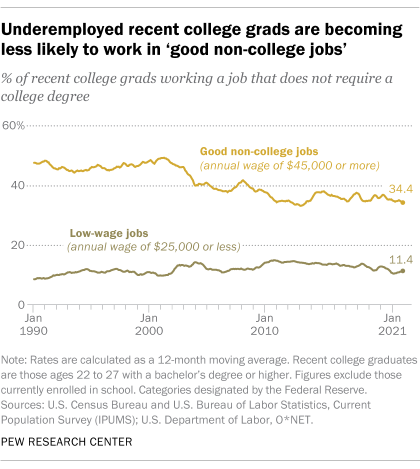
Current faculty graduates are extra probably than graduates general to be underemployed – that’s, working in jobs that sometimes don’t require a university diploma, in keeping with an evaluation of Census Bureau and BLS knowledge by the Federal Reserve Financial institution of New York. As of December 2021, 41% of school graduates ages 22 to 27 have been underemployed, in contrast with 34% amongst all faculty graduates. The underemployment charges for current faculty grads rose in 2020 because the COVID-19 outbreak strained the job market, however have since returned to pre-pandemic ranges.
As of the tip of 2021, solely 34% of underemployed graduates ages 22 to 27 labored what the Fed defines as “good non-college jobs” – these paying not less than $45,000 a yr – down from round half within the Nineteen Nineties. The share of underemployed graduates ages 22 to 27 in low-wage jobs – these incomes lower than $25,000 yearly – rose from about 9% in 1990 to 11% final yr.
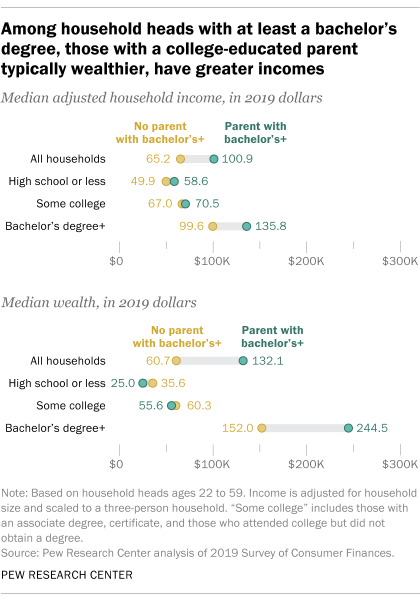
In the case of earnings and wealth accumulation, first-generation faculty graduates lag considerably behind these with college-educated mother and father, in keeping with a Might 2021 Pew Analysis Middle evaluation. Households headed by a first-generation faculty graduate – that’s, somebody who has accomplished not less than a bachelor’s diploma however doesn’t have a dad or mum with a university diploma – had a median annual earnings of $99,600 in 2019, in contrast with $135,800 for households headed by these with not less than one dad or mum who graduated from faculty. The median wealth of households headed by first-generation faculty graduates ($152,000) additionally trailed that of households headed by somebody with a dad or mum who graduated from faculty ($244,500). The upper family earnings of the latter facilitates saving and wealth accumulation.
The hole additionally displays variations in how people finance their training. Second-generation faculty graduates have a tendency to come back from extra prosperous households, whereas first-generation faculty graduates usually tend to incur training debt than these with a college-educated dad or mum.
Most People with faculty levels see worth of their expertise. Within the Middle’s October 2021 survey, majorities of graduates mentioned their faculty training was extraordinarily or very helpful when it got here to serving to them develop personally and intellectually (79%), opening doorways to job alternatives (70%) and growing particular expertise and information that may very well be used within the office (65%).
Youthful faculty graduates have been much less probably than older ones to see worth of their faculty training. For instance, solely a 3rd of school graduates youthful than 50 mentioned their faculty expertise was extraordinarily helpful in serving to them develop expertise and information that may very well be used within the office. Amongst faculty graduates ages 50 and older, 45% mentioned this.






























































